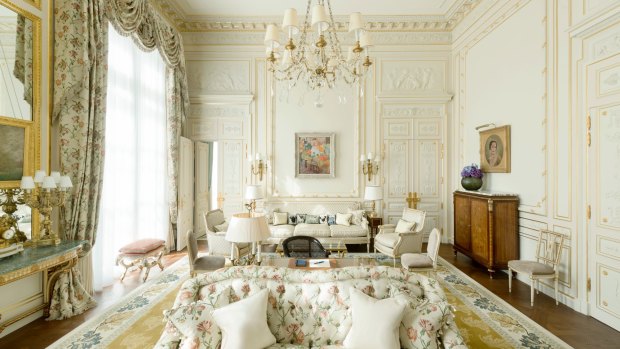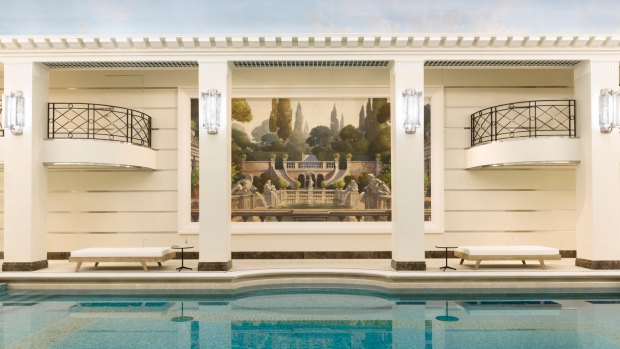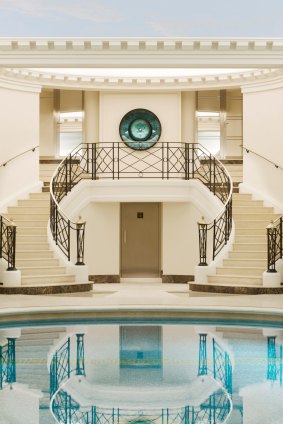This was published 7 years ago
Paris Ritz hotel becomes a palace after $620m renovation
By Lee Tulloch

Windsor Suite Windsor at the Ritz Paris.
When the venerable Ritz Paris closed in 2012 for four years of renovations, its loyal guests were forced – quelle horreur! – to stay in other Parisian hotels. This was too much for some, however, according to one long-time Ritz staffer. These guests simply bought their own Parisian apartments rather than stay with the competition.
Those loyal customers will be very pleased when they return to the hotel, which reopened in July. Plus ca change, as they say in France. The more things change, the more they stay the same. The Ritz has been expensively and extensively overhauled, with the addition of state-of-the-art technology, a new, retractable roof over the winter garden, transforming it into a year-round patio, a smart new Chanel spa and a freshly landscaped Grand Jardin of linden trees and white flowers at the hotel's heart, but in essence it's not very different at all.
The much-loved hotel, the icon of hotel icons, is fresh and dazzling but about 90 per cent of the antique furniture, light fixtures and furnishings was retained, stored in 124 containers and then restored. All the familiar architectural details, such as the oak woodwork, the Mareuil stone floors and parquetry were repaired, along with 1500 square metres of roofing, involving 48,000 tiles. Because the hotel is a listed monument, its facade on Place Vendome, designed by royal architect Mansart in the late 17th century, was carefully restored under the supervision of the head architect of the Monuments Historique, Alain-Charles Perrot.

The revamped hotel has added the smart new Chanel Spa, located in the Ritz club.
Interior designer Thierry Despont has hardly altered the Grand Siecle ambience, which is a relief to those who loved the Ritz as it was. The building was formerly the mansion of aristocrats the Duke of Lauzun and the Duke of Gramont and they would still find themselves very much at home with the Louis XVI furniture, the frescoed ceilings, the gilded mirrors and the great swags of velvet and taffeta lining windows and alcoves.
Historic touches from the days of Cesar Ritz, who established the hotel in 1898, remain – the gold swan faucets, the gold key master switch, the pull cords to call valet and maid, and the peach towels and bathrobes that Ritz introduced because he thought it the most flattering colour against a woman's skin. The hand-painted Marthe porcelain by Haviland, which first appeared on Ritz tables in 1898, is still gracing the tables of the hotel's opulent restaurant L'Espadon and the Salon Proust, where tea is served in the afternoons.
And most importantly, while it too has been refreshed, the famous Hemingway Bar is still cosy, the room hung with memorabilia of the great writer and hunter, who made it his watering hole during WWII and supposedly "liberated" it from the Nazis in 1944. Legendary barman Colin Field is still pouring the signature cocktail, Serendipity 1994, now €30 a pop.

The Ritz Club: The indoor pool is dubbed the finest in Paris.
Cesar Ritz had humble beginnings in Switzerland before he became a wine waiter in Paris and later stormed his way into becoming the most important hotelier of his era and perhaps all time. He had intended that his Paris hotel be "hygienic and comfortable" with "all the refinements a Prince might find in his own residence". And ever since the hotel's opening 118 years ago, it has drawn princes of every kind, from writers such as Proust, who wrote A la Recherche du Temps Perdu there in 1909, Graham Greene and F. Scott Fitzgerald, to the composers Chopin and Cole Porter, and Princess Diana who spent her last few hours on Earth there in 1997. High Priestess of fashion, Miranda Priestly (Meryl Streep) stayed at the Ritz in the movie The Devil Wears Prada, as does the film and novel's inspiration Anna Wintour.
Coco Chanel was a famous resident, and lived there from WWII until her death in 1971. For a time during the war, when the Vendome side of the Ritz was commandeered as HQ for the German Luftwaffe, Herman Goring lived in the other half of the hotel. The new Chanel spa, with signature treatments, a make-up room and a hair salon by Australian David Mallett, is decked out in black and sand, her colours, and fabric gardenias are placed on the beds of the treatment room in homage. Her suite, which sells for €25,000 per night, has been updated with the same Chanel colour scheme.
The hotel's last renovation was in the early 1980s after it found a new owner, the Egyptian businessman Mohamed Al-Fayed. In 2010 the Paris tourist ministry decided to grant a new category, "palace", to hotels of exceptional hospitality. Many were surprised that the Ritz failed to make the list. The $620 million renovation is planned to elevate the Ritz to this category and compete with the glitzier (but not ritzier) Asian-managed hotels – Le Royal Monceau, the Peninsula, the Mandarin Oriental and the Shangri-La.
The plan suffered a setback in January when a fire consumed the second building on rue Cambon and destroyed its 7th floor, attic and roof. An electrical fault is thought to be to blame. That building is still under wraps. When it opens later this year, the hotel will have 142 rooms, including 71 suites, down from 159.
Innovations include a relaxing of front desk rules, which allows guests to check-in and out at their convenience, especially handy for Australians arriving at the crack of dawn. There's the addition of Salon Vendome, an opulent function facility, which can host 200 people for seated events. The long gallery of high-end boutiques and retailer's vitrines, known as "temptation walk", now features more fashion-forward clothing and jewellery boutiques.
And there's a new Ritz concept store that stocks well-chosen items, such as a cute Mon Ritz Paris toy suitcase for kids and candles of the Ritz's signature fragrance, Ambre. Collaborations with international designers of note will feature every six months.
Gastronomy at the Ritz has also had a rethink with the arrival of chef Nicolas Sale, who has four Michelin stars from his two restaurants in Courcheval. Sale has modernised the cuisine served in L'Espadon and its terrace. Think langoustine cannellonis with Meursault sauce and tender breast of pigeon served with pasta stuffed with spinach and ricotta.
Particularly enticing is the new afternoon tea, a la français, served in the Salon Proust, a sumptuous room with a marble fireplace and lined with bound books. Appropriately for a room named for the great writer about nostalgia, pastry chef Francois Perrett has revisited the sweet treats of his childhood, such as sugar tarts, teddy bear shortbreads filled with lemon marshmallow and little barquettes, or boats, filled with jam, served on cake stands with a selection of more than 27 tea varieties.
Perrett believes that biscuits are more agreeable with tea than creamy cakes. In homage to Proust, the sublime Ritz madeleines are king-sized, flavoured with orange blossom and glazed with crunchy lemon. The teapots have little gold madeleines on their lids. Tea is served from 2pm to 6 pm, and it's the perfect opportunity to put on the Ritz, even if you're not staying in the hotel.
Francois Perrett and Nicolas Sale are both successors to the great chef and restaurateur Auguste Escoffier, who popularised French haute cuisine in the early 20th century and whose Le Guide Culinaire remains a major textbook for cooks. "Good cooking is the basis of true happiness," he famously said. In 1884, Escoffier was hired by Cesar Ritz to run the kitchens at Ritz's Grand Hotel in Monte Carlo. In 1890, Ritz and Escoffier joined Richard D'Oyly Carte at his new Savoy Hotel in London and reinvented hotel dining, wooing aristocratic women, who would be seen dining in public for the first time.
Escoffier created his famous peche Melba and Melba toast at the Savoy, but the glory days didn't last – he and Ritz were dismissed in 1898 for gross mismanagement, including taking bribes from suppliers. The Ritz Hotel Development Company was then established and Escoffier went on to set up the kitchens and hire chefs for Ritz's new hotels, including the Ritz Paris, the Ritz London and the Ritz Madrid. (The North American hotel chain Ritz-Carlton began as an offshoot of Ritz's company in 1911, but has no current connection.)
The hotel's culinary school, Escoffier Ritz Paris, has carried on the Escoffier legacy since 1988. It's found in the basement of the hotel, overlooking the sparkling, renovated kitchens. A world-renowned teaching institution for professional chefs, enthusiastic amateurs and those wishing to enter the profession, the Escoffier school holds year-round classes in French and English simultaneously, and offers everything from diplomas in advanced culinary arts to children's classes. Classes and tastings accommodate up to 40 people.
The school's chefs delved into the hotels archives to find recipes dating back to 1898, but innovation is also fostered. The 19-week pastry-making course sounds particularly tempting. What's not to love about a teacher who says, "Cooking without butter is sad"?
This glorious world where "the customer is always right" is pricey, naturellement. It might be vulgar to talk about tariffs, but rooms start from €1300 per night. A "prestige" breakfast is €120 per head (the American breakfast is €60.) The Le Temps Sublime 1 hour 30 minute Chanel facial will set you back €360. Bar Hemingway's most expensive drink, the Ritz Sidecar, made with an 1834 vintage cognac, sells for €1500 a glass. (They've sold three since the hotel reopened in July.)
But it is the Ritz. And it is still wonderful.
Your room is ready.
Qantas flies to London LHR daily from Sydney and Melbourne via Dubai. qantas.com
Regular Eurostar services connect from Saint Pancras station to Gare du Nord Paris. Trip time: two hours 16 minutes. eurostar.com
STAYING THERE
The Ritz is situated in the 1er arrondissement of Paris, a short walk from the rue du Rivoli, the Tuileries Garden and the premier shopping street rue St.-Honore. Reservations: (61-2) 9377 8444; lhw.com
The writer was the guest of Leading Hotels of the World and Qantas
FIVE THINGS THE RITZ GAVE TRAVEL
1 Cesar Ritz transformed luxury hospitality to such a degree that his last name is forever associated with ostentatious luxury and glamour. "Ritzy" is now an adjective travellers use for the most sumptuous five-star accommodation and experiences. According to Webster's dictionary, "ritzy" means: "1. snobbish 2. ostentatiously smart 3. fashionable, posh"
2 Cesar Ritz is credited as the first person to decree "Le client n'a jamais tort" ('The customer is never wrong') which has become the mantra of everyone in service industries.
3 One of Ritz's hotels, the Grand Hotel Rome, was the first in the world to have a private bathroom in every suite.
4 The Ritz Paris was the first hotel to have en suite bathrooms, a telephone and electricity in every room.
5 Along with his colleague, chef Escoffier, Ritz made the idea of dining in a hotel fashionable. Previously, women were not seen in hotel dining rooms. He introduced the concept of indirect lighting in the restaurant, so that his customer's jewels wouldn't glitter unflatteringly.
Sign up for the Traveller Deals newsletter
Get exclusive travel deals delivered straight to your inbox. Sign up now.